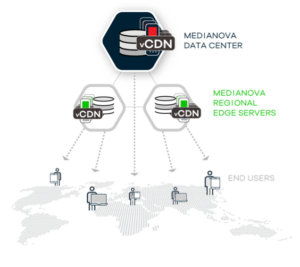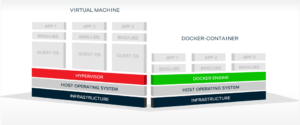

The Latest CDN Technology of Medianova: Virtualized CDN (vCDN)
vCDN (virtualized CDN) is a platform that provides high performance and agile services compared to traditional CDNs with its containerized functions.
To better understand vCDN, let us first refresh the concepts of CDN.
What is CDN?
CDN can simply be defined as a cloud computing service that aims to deliver digital contents of websites such as images, music, and video to the end users from the closest location with high performance.
This service caches a copy of the content of websites in geographically distributed PoPs (Points of Presences) containing servers and software. It provides quick access to the contents from the geographically nearest PoP by identifying the regional location of the end users with the DNS servers.

The download speed and security of the websites of organizations (e-commerce, media, and games) that has millions of visitors are very important.
It is difficult, costly and risky to respond to the requests of these visitors only from the Origin Server. Due to its geographically distributed architecture, CDN has eliminated these risks by delivering contents faster and safer from various points according to the locations of the end users.
Since 2005, Medianova delivers the contents of its customers to the end users with its high-performance CDN.
The Evolution of Traditional CDNs
With the Internet usage growth, traditional CDN architectures became insufficient responding to this increase in demand. R&D studies accelerated to fill this gap.
The main topics in these studies are resource utilization efficiency, response time, performance, cost and service quality. Medianova R&D Team has been working on these topics for many years to improve the quality of its products.
vCDN with Medianova
In traditional CDN architectures, individual hardware devices are provided for each content type and network functions. It has been determined that this method forms the basis of the problems in the resource efficiency measurements. The solution here is to use the devices for more than one function by using virtualization technologies.
Now let’s take a look at how these problems are solved with vCDN (virtualized CDN) architecture.
Virtualized CDN (vCDN)

In traditional CDNs, each function is performed by a separate physical machine, causing unnecessary resource consumption.
When these functions are not needed during the day, the machines run with idle time. Similarly, when the demands on functions are increased a lot, latency occurs in response times.
vCDN distributes the resources with virtualized network functions (VNF) according to needs. Because virtualized network functions can be quickly defined on all machines, each source is not reserved for a single function. Thus, each resource can serve different functions according to need.
Medianova Team tried legacy virtualization software for many years with no luck. They were not using the hardware efficiently in heavy loads.
Using container technology in vCDN offers much better solutions than using conventional virtual machines. The reason for this;
Containers are virtual structures that do not need a guest operating system. They use the operating system and core of the host machine. Unlike other virtualization technologies, it is not necessary to allocate a specific space on the CPU, RAM, and disk for containers.
It is much faster than hypervisor-based virtualization and it is the same as the physical machine in performance. The main reason for this is the direct processing via the kernel does not require a middleware like Hypervisor.

In vCDN, the entire system architecture is turned into a Docker container-based virtual cloud-computing platform. With dynamic measurements, content request densities are determined. Containers are deployed for the network functions where the requests increase. Containers are dropped for the network functions where the requests decrease. In this way, resources are used at the optimum level by sharing with the required functions. Resource sharing in a container-based vCDN is flexible and fast.
Advantages of vCDN:
Resource Sharing: The machines which are under too many requests are supported by the machines with idle time. Therefore, resources are utilized with maximum performance. It increases the efficiency of resource utilization by reducing the delays and creating a higher performance system while evaluating the remaining resources.
Cost: When the resources become efficient, the distribution cost will decrease, as the number of machines used for the same unit work will be reduced. In this way, we will both enhance the quality of service we offer to our customers and reduce the cost in parallel.
Performance: With this brand new vCDN approach our customers will be able to:
- Use the latest CDN technology available since we work with the latest platform technology.
- Enjoy a better performance due to platform stability and efficiency.
- Run their own microservices on our platform.
- Benefit from our service from different locations, since we can quickly set a POP in decreased bandwidth quality locations.
The latency time graphs of traditional CDN – container CDN structures for responding to requests is shown in the figure below. As clearly seen vCDN responds to requests with more stablity and lower latency.

Medianova is now serving a brand new vCDN approach with the original algorithmic module developed as a result of R&D activities. Medianova increased its network utilization capacity and resource utilization efficiency by over 60% with vCDN. Medianova has taken another step towards delivering a much higher performance service.





